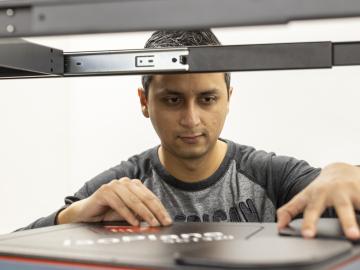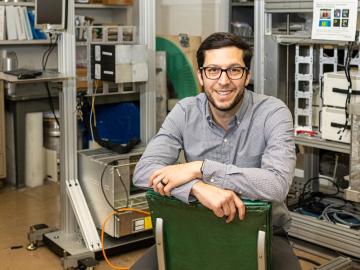
Filter News
Area of Research
- (-) Nuclear Science and Technology (38)
- (-) Supercomputing (62)
- Advanced Manufacturing (8)
- Biology and Environment (24)
- Computer Science (2)
- Electricity and Smart Grid (3)
- Energy Frontier Research Centers (1)
- Energy Science (138)
- Fuel Cycle Science and Technology (1)
- Functional Materials for Energy (2)
- Fusion and Fission (30)
- Fusion Energy (14)
- Isotope Development and Production (1)
- Isotopes (7)
- Materials (132)
- Materials Characterization (2)
- Materials for Computing (17)
- Materials Under Extremes (1)
- National Security (17)
- Neutron Science (33)
- Nuclear Systems Modeling, Simulation and Validation (2)
- Quantum information Science (2)
- Sensors and Controls (1)
- Transportation Systems (2)
News Topics
- (-) Advanced Reactors (12)
- (-) Frontier (32)
- (-) Grid (5)
- (-) Materials (15)
- (-) Nanotechnology (11)
- (-) Nuclear Energy (39)
- (-) Transportation (6)
- 3-D Printing/Advanced Manufacturing (8)
- Artificial Intelligence (37)
- Big Data (22)
- Bioenergy (9)
- Biology (11)
- Biomedical (19)
- Biotechnology (2)
- Buildings (4)
- Chemical Sciences (5)
- Computer Science (97)
- Coronavirus (14)
- Critical Materials (3)
- Cybersecurity (9)
- Energy Storage (8)
- Environment (23)
- Exascale Computing (26)
- Fusion (9)
- High-Performance Computing (43)
- Isotopes (7)
- Machine Learning (15)
- Materials Science (19)
- Mathematics (2)
- Microscopy (7)
- Molten Salt (5)
- National Security (8)
- Neutron Science (17)
- Partnerships (1)
- Physics (10)
- Polymers (2)
- Quantum Computing (20)
- Quantum Science (25)
- Security (6)
- Simulation (16)
- Software (1)
- Space Exploration (8)
- Summit (43)
Media Contacts

Oak Ridge National Laboratory researchers working on neutron imaging capabilities for nuclear materials have developed a process for seeing the inside of uranium particles – without cutting them open.

A software package, 10 years in the making, that can predict the behavior of nuclear reactors’ cores with stunning accuracy has been licensed commercially for the first time.

The techniques Theodore Biewer and his colleagues are using to measure whether plasma has the right conditions to create fusion have been around awhile.

OAK RIDGE, Tenn., Feb. 19, 2020 — The U.S. Department of Energy’s Oak Ridge National Laboratory and the Tennessee Valley Authority have signed a memorandum of understanding to evaluate a new generation of flexible, cost-effective advanced nuclear reactors.

The prospect of simulating a fusion plasma is a step closer to reality thanks to a new computational tool developed by scientists in fusion physics, computer science and mathematics at ORNL.

Gina Tourassi has been appointed as director of the National Center for Computational Sciences, a division of the Computing and Computational Sciences Directorate at Oak Ridge National Laboratory.

As scientists study approaches to best sustain a fusion reactor, a team led by Oak Ridge National Laboratory investigated injecting shattered argon pellets into a super-hot plasma, when needed, to protect the reactor’s interior wall from high-energy runaway electrons.

Students often participate in internships and receive formal training in their chosen career fields during college, but some pursue professional development opportunities even earlier.

If humankind reaches Mars this century, an Oak Ridge National Laboratory-developed experiment testing advanced materials for spacecraft may play a key role.

Jason Nattress, an Alvin M. Weinberg Fellow at the Department of Energy’s Oak Ridge National Laboratory, found his calling on a nuclear submarine.


